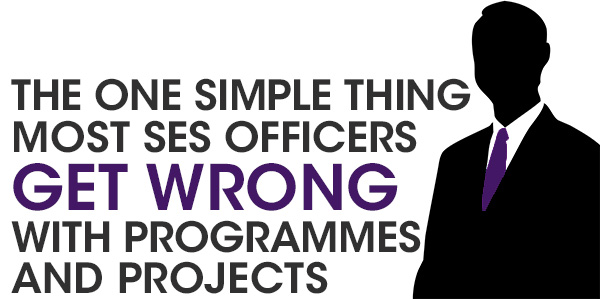There is one simple thing most SES officers get wrong with programmes and projects, and it is this: they think about them the wrong way.
Common Misconceptions
Whenever I mention to that I specialise in programme and project management to senior executives, it is always interesting to see what kind of responses I get. They are many and varied, but body language and facial expressions can often signal private thoughts:
- blank stares (“why would that be of any interest to me?”);
- knowing smiles (“that’s nice, though you look too old to be an IT person”);
- mild alarm (“are you a threat to my world?”);
- involuntary eye-rolling (“I’m getting tired of you template-warriors”);
- utter disdain (“haven’t you heard we have Agile now? – project management is so 1980s”)
(I admit there are some very positive ones but negative responses are surprisingly common.)
Now, I don’t think anyone gets to be an SES officer without displaying leadership qualities, intelligence and a broad range of capabilities. So why are such high-calibre individuals responding negatively at the mere mention of programmes and projects? It is because of what they think those things are. Some examples:
- projects are what we call the major tasks the CIO’s area is undertaking;
- projects are the way we control our spending on capital works;
- projects are pieces of work I get my team to undertake;
- projects are the way Defence spends money (lots of it);
- programmes are what the policy people think up for the service delivery people to deliver;
- programmes are the way we monitor, evaluate and report on major government expenditure;
- (programmes should be spelled programs because… blah blah blah… you get the idea!)
How should SES officers think about programmes and projects?
The answer is simple. The dominant way SES officers should look at programmes and projects is as organisations. Temporary ones. A programme is an organisation, and a project is an organisation (a smaller one).
To do this requires a mental re-frame (indeed a couple of them). Forget all about your permanent structures, they are valueless in the world of change. Pretend they don’t exist. Then look at the programme/project you are about to embark upon, and establish it as a new (and temporary) organisation the same way you would if you were setting up a brand new Group, Division or Branch.
You will need positions – roles – to direct, manage and undertake the work. Principles by which the organisation runs. Governance arrangements, processes and standards. Ways to plan and delegate and set priorities. Ways to check progress, deal with problems, change priorities. Resources. Funding. The list goes on.
When an SES officer thinks about setting up a programme or project the way they would think about setting up a brand new Group, Division or Branch, they are far more likely to give it the degree of rigour, attention, time and effort it deserves. Contrast that with the all too common solution: “yeah, we’ll need to get a firm/someone in on contract to run that, make sure the PMO gives them the templates”.
Programmes and projects are the vehicles by which we introduce significant change, and if you don’t apply the right disciplines skilfully to manage them things are inevitably going to go wrong. The best place to start is by having senior executives look at programmes and projects first and foremost as organisations in their own right.
Want to know more?
If you would like to know more about running programmes and projects as temporary organisations in the APS, please call me personally on 0407 404 688 or email me at john.howarth@tannerjames.com.au. I would be very happy to come to meet you, answer questions and provide further information.
What do you think?
Please feel free to comment on the blog itself or via LinkedIn.






Leave A Comment